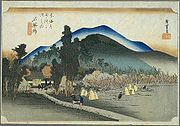
Ishiyakushi-juku
Encyclopedia

53 Stations of the Tokaido
The are the rest areas along the Tōkaidō, which was a coastal route that ran from Nihonbashi in Edo to Sanjō Ōhashi in Kyoto.-Stations of the Tōkaidō:...
of the Tōkaidō
Tokaido (road)
The ' was the most important of the Five Routes of the Edo period, connecting Edo to Kyoto in Japan. Unlike the inland and less heavily travelled Nakasendō, the Tōkaidō travelled along the sea coast of eastern Honshū, hence the route's name....
. It is located in the present-day city of Suzuka
Suzuka, Mie
is a city located in Mie, Japan.As of 2011, the city has an estimated population of 198,716 and the density of 1,020 people per km². The total area is 194.67 km².Located about 83 km east from Nara, and 52 km southwest from Nagoya.-History:...
, Mie Prefecture
Mie Prefecture
is a prefecture of Japan which is part of the Kansai regions on Honshū island. The capital is the city of Tsu.- History :Until the Meiji Restoration, Mie prefecture was known as Ise Province and Iga Province....
, Japan
Japan
Japan is an island nation in East Asia. Located in the Pacific Ocean, it lies to the east of the Sea of Japan, China, North Korea, South Korea and Russia, stretching from the Sea of Okhotsk in the north to the East China Sea and Taiwan in the south...
. It received its name from the nearby Buddhist temple, Ishiyakushi-ji.
History
Ishiyakushi-juku was established in 1616, as part of the Edo periodEdo period
The , or , is a division of Japanese history which was ruled by the shoguns of the Tokugawa family, running from 1603 to 1868. The political entity of this period was the Tokugawa shogunate....
's Tōkaidō. Originally, there had been no post stations
Shukuba
were post stations during the Edo period in Japan, generally located on one of the Edo Five Routes or one of its sub-routes. They were also called shukueki . These post stations were places where travelers could rest on their journey around the nation...
between Yokkaichi-juku
Yokkaichi-juku
was the forty-third of the fifty-three stations of the Tōkaidō. It is located in the present-day city of Yokkaichi, in Mie Prefecture, Japan. It was 12.8 km from Kuwana-juku, the preceding post town.-History:...
and Kameyama-juku
Kameyama-juku
was the forty-sixth of the fifty-three stations of the Tōkaidō. It is located in the present-day city of Kameyama, in Mie Prefecture, Japan.-History:During the Edo period, Kameyama-juku served as both a post town and a castle town for Kameyama Castle...
, so Ishiyakushi-juku was formed with about 180 buildings at its inception. The Ozawa family managed the honjin
Honjin
thumb|250px|The honjin at [[Inaba Kaidō]]'s [[Ōhara-shuku]]. is the Japanese word for an inn for government officials, generally located in post stations during the later part of the Edo period.-Evolution of Honjin:...
in the town and kept many records, which are still available today in a local archives museum.

